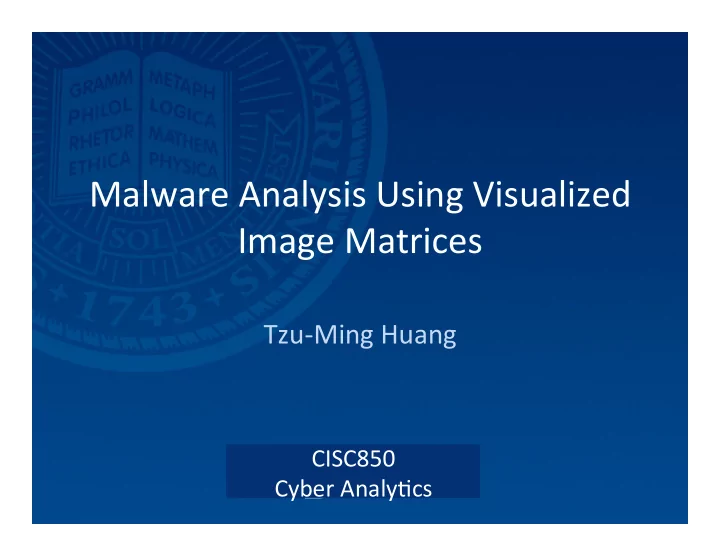

Malware Analysis Using Visualized Image Matrices Tzu-Ming Huang CISC850 Cyber Analy@cs
CISC850 Cyber Analy@cs Overview • malware visual analysis method – convert binary files into images • Reduce computa@on – major block – similarity calcula@on method between these images
Method Overview
Extract opcode sequences from binary 1. 2. 3. 1.
Repe@@on Filtering
Extract opcode sequences from binary 1. 2. 3. 1.
Major Block Selec@on • Not all of the basic blocks (file header, meaning less blocks) • Target suspicious behavior • Blocks include “CALL” instruc@on
Major Block Selec@on
Extract opcode sequences from binary 1. 2. 3. 1.
Parsing Opcode Sequence • First three characters of opcode – 41.4% of opcodes have3 characters – Meaning is maintained – Eg. PUSH -> PUS; CALL -> CAL; OR? • These three-character opcodes are concatenated together
Parsing Opcode Sequence
Generate Image Matrix • Use hash func@on ( SimHash ) to decide X-Y coordinate and RGB colors of the pixels • Length and width of matrix are 2 n (8) • If hash in same X-Y coordinate, simply sum the RGB colors value
Generate Image Matrix
Choose Representa@ve Image Matrix
Similarity Calcula@on Using Image Matrix • Faster performance than opcode string comparison • Finding pairs in string: O(n 2 ) • Simhash and calculate similarity in image: O(n)
Similarity Calcula@on Using Image Matrix
Similarity Calcula@on Using Image Matrix • vector angular-based distance measurement algorithm – Pixels are viewed as 3D vector
Similarity Calcula@on Using Image Matrix
Experiment: Major Blocks Selec@on?
Experiment: Major Blocks Selec@on?
Experiment: Feasibility
Experiment: Feasibility • Similarity of sample malwares from same family: 0.19 ~ 0.36 • Similarity of sample malwares from different family: < 0.05 • Classifica@on accuracy = 0.9896
Recommend
More recommend